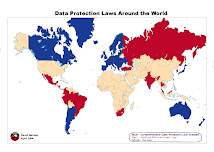The press release from the FSA below, even though widely expected, will have far reaching effects in how the regulator will view a firm’s assessment of a senior candidate’s competencies. I have no doubt the FSA will be seeking for examples of non-compliance, so it is probably a good idea to go over the files of senior individuals and make sure that all the required information is in place. As part of this requirement, I would also recommend that you keep on file any notes made during interview that support your assessment of the person’s competency.
________________________________________________
The Financial Services Authority (FSA) has written to the CEOs of 5,000 regulated firms to reinforce how its intensive regulatory approach applies to approving and supervising senior personnel performing significant influence functions (SIFs).
The letter reminds CEOs that the responsibility to assess whether a candidate is fit and proper to carry out a role rests with the firm and that firms should, therefore, have robust recruitment, referencing and due diligence processes in place.
As part of the SIF approval regime, the FSA has said it will undertake close vetting of appointments and will expect to interview candidates applying for SIF roles. Therefore, firms are being encouraged to engage with the FSA early in the recruitment process and for major firms, this should be at the point of drawing up a shortlist rather than waiting until the preferred candidate stage.
Firms are also urged to provide sufficient information with their applications (including supporting documents – for example head-hunter reports) and the rationale they have used to conclude that the candidate is fit to proper to perform the role. Applications must be made in a timely manner and any failure to engage promptly with the FSA may impede a firm’s plans to publicly announce a new appointment.
The enhanced SIF regime is one of the FSA’s responses to the financial crisis, which exposed governance and risk management shortcomings across numerous firms in roles such as chair, CEO, and finance or risk director. In the 12 months since October 2008 the FSA has conducted 172 SIF interviews, resulting in 18 candidates withdrawing their applications which shows there is considerable scope for some firms to be more robust in their own recruitment processes.
Graeme Ashley-Fenn, FSA director of permissions, decisions and reporting, said:
“It is crucial, that at a time when effective governance has never been more important, candidates have the right levels of competence and capability to perform these senior roles and that they are fully aware of their responsibilities.
“The onus is on firms to ensure candidates applying for influential positions are fit and proper to perform the role. Our individually tailored approval interviews will help us assess whether the individual has the right experience and understanding but also whether they will enhance the overall management strength and insight of the firm.”
NOTES FOR EDITORS
The FSA now interviews all candidates for SIF positions and in August 2009, extended the scope to include people employed by an unregulated parent undertaking or holding company, whose decisions or actions are regularly taken into account by the governing body of a regulated firm and to all proprietary traders who are not senior managers but who are likely to exert significant influence on a firm. These changes came into effect on 6 August 2009, with a transitional period of six months.
Wednesday 14 October 2009
Wednesday 7 October 2009
Powerchex warn that temps require the same level of pre-employment screening as permanent employees
I am sure that everyone has been appauled by the lapses in control that led to innocent children being abused by the people they should trust most, their childminders. This should serve as a reminder that a proper pre-employment screening policy should not exclude casual workers.
____________________________________________________________
A convicted child sex offender was able to obtain employment in a nursery after staff failed to carry out the required pre-employment screening checks.
Andrew Smith was employed in the kitchen of Norwood Manor Day Nursery through employment agency Reed despite his name appearing on the sex offender’s register after he was caught sending a string of perverted internet messages and webcam footage of him performing a solo sex act to someone he thought was a 13-year-old girl, but was in fact an undercover police officer.
Smith subsequently served 6 months of a 12 month jail sentence and was placed on the sex offenders register for 10 years. The Criminal Records check that is required for those working in nurseries would have revealed this but staff failed to comply.
Alexandra Kelly, a Director at Powerchex, one of the leading pre-employment screening providers, believes that Smith being a temporary employee is no excuse for a low level of vetting, “We advise our clients to determine the level of vetting required using a risk based approach. Temporary workers pose the same, if not a bigger risk to the company than permanent employees. With temps there is an emphasis on the speed of vetting but companies should work closely with their provider of pre-employment screening to ensure that this need does not prevent proper due diligence taking place.”
____________________________________________________________
A convicted child sex offender was able to obtain employment in a nursery after staff failed to carry out the required pre-employment screening checks.
Andrew Smith was employed in the kitchen of Norwood Manor Day Nursery through employment agency Reed despite his name appearing on the sex offender’s register after he was caught sending a string of perverted internet messages and webcam footage of him performing a solo sex act to someone he thought was a 13-year-old girl, but was in fact an undercover police officer.
Smith subsequently served 6 months of a 12 month jail sentence and was placed on the sex offenders register for 10 years. The Criminal Records check that is required for those working in nurseries would have revealed this but staff failed to comply.
Alexandra Kelly, a Director at Powerchex, one of the leading pre-employment screening providers, believes that Smith being a temporary employee is no excuse for a low level of vetting, “We advise our clients to determine the level of vetting required using a risk based approach. Temporary workers pose the same, if not a bigger risk to the company than permanent employees. With temps there is an emphasis on the speed of vetting but companies should work closely with their provider of pre-employment screening to ensure that this need does not prevent proper due diligence taking place.”
Thursday 1 October 2009
The Truth Behind Foreign Identity Documents
How many of you find it really difficult to decide whether the documents you are looking at are legitimate. The truth is that most HR professionals have trouble with the numerous documents that they are presented by today's international workforce. Powerchex works with Keesing Reference systems who have developed a brilliant database of travel documents from around the world. If you would like to know more about how to benefit, give us a call at Powerchex. In the meantime, here is an article, by Daniel Suess, the sales manager at Keesing, explaining how to spot questionable documents.
_____________________________________________________
Challenged when checking foreign passports and ID cards?
Here’s why ...
The number of ID documents currently in circulation is staggering. Every year, 208 countries issue countless documents, ranging from passports, ID cards and driving licences to visas and work permits. What’s more, 150 new document types join the existing pool on an annual basis.
Given the complexity and sheer volume of documents in issue, the authentication of ID documents presents HR departments with a considerable challenge. Indeed, many HR professionals feel that a document’s authenticity can only be established by professional inspectors using bespoke equipment.
And yet the employer is officially legally responsible for inspecting these documents…!
How do you check a Chinese passport?
In practice, day-to-day responsibility for the authentication of ID documents if often assigned to the HR department. As a consequence, HR staff may well be presented with an ID document they’ve never seen before. How, for example, would you authenticate a passport presented by a Chinese applicant? The Chinese passport has its own unique (security) features, including a watermark, an electronic data chip, and a UV feature, for example. The authenticity of a document can often be established on the basis of these features.
So which features should you look for? How, for that matter, would you establish if the individual in question requires a work permit? More often than not, it’s up to the HR department to answer these questions.
An ID document contains unique data. Think, for example, of the personal particulars (the holder’s name, date of birth, tax and social insurance number, etc) and the Machine Readable Zone or MRZ - a magnetic strip, usually located near the foot of the document, containing an alphanumeric code. This unique code is creating by applying an algorithm to the document data. Research has shown that more than 80% of all forgeries and counterfeits are uncovered because the MRZ code is incorrect.
Most people are familiar with only a small number of ID documents. While most employers will recognise a UK passport, few will be familiar with a Polish or Senegalese ID document. Another thing to bear in mind is that recognising a passport is not quite the same as spotting a counterfeit.
Help from the authorities?
To compensate for their inexperience and limited know-how, HR departments are encouraged to draw on the expertise of public-sector organisations such as the Home Office. Unfortunately such assistance doesn’t necessarily allow them to establish the authenticity of all ID documents they encounter. This is because public-sector organisations tend to focus on the inspection and verification of domestic ID documents. As a consequence, their experience is not always relevant to employers that recruit foreign staff.
Legal obligation to inspect and verify ID documents
To tackle identity fraud and illegal working, parliament passed the Law for Employers on Preventing Illegal Working in 2008. Under this law, employees are responsible for preventing illegal working, while the authorities are responsible for monitoring compliance. Employers who knowingly or otherwise recruit illegal workers risk a fine or even a prison term. This makes it all the more important that employers are in a position to inspect ID documents presented by (potential) employees.
The best and probably the only way to avoid illegal working is therefore to establish the identity of a potential employee before he or she is recruited. Ideally, the inspection and verification of ID documents forms part of the employee screening process, allowing the employer to meet its legal obligation to verify an applicant’s identity before offering him or her a contract.
Any employer that fails to comply could face a hefty fine. Indirect damage, including a loss of reputation, can also be substantial. Faced with these prospects, companies are understandably keen to avoid employing illegal workers. While many companies are eager to comply with current legislation, thereby avoiding illegal employment and related fines, few have found an appropriate solution yet.
The extent to which fraud involving counterfeit and stolen ID documents affects the corporate sector and society at large should not be underestimated. Identity fraud is part and parcel of everyday life - its scope increases each year, and the annual losses sustained by its victims run into billions of pounds. Identity fraud is increasingly common in the UK. According to the Association of Chief Police Officers (ACPO), fraud costs the UK taxpayer approximately £20 billion a year. Surprisingly, employees are among the worst culprits, putting employers in a particularly precarious position.
Last but not least: prevention better than cure
Embedding passport checks in the employee screening process allows you to establish the identity of an applicant, thus avoiding (fines for) employing illegal workers. Document checks can also act as a deterrent – a potential fraudster will think twice before applying to a company that verifies applicant identities as a matter of policy. Here too, prevention is better than cure. The development and implementation of internal recruitment procedures reduces recruitment-related risk and avoids illegal working. It also allows you to comply with prevailing legal requirements. The right combination of tools, software and reference materials should enable any organisation to conduct reliable checks.
10 practical tips when checking passports and ID cards
Only accept secure ID documents. In other words, documents that contain security features, such as passports and ID cards. Ask yourself whether a driving licence is acceptable. Generally speaking, these documents do not specify the holder’s nationality. Neither do they necessarily include a photograph. Documents that do not have security features, such as gas bills or bank statements, should never be accepted other than for address verification.
Always check the original ID document – do not accept copies. Make sure you copy or scan documents for your own records (remember to obtain the holder’s permission first).
Always follow the same inspection procedure and be mindful of details.
Always check more than one security feature.
Carefully compare the photograph in the document to the individual who presented it. Pay specific attention to the distance between the eyes, ears, lips and chin rather than the colour or length of his or her hair.
Ask the holder’s age and verify the answer based on the date of birth recorded in the document.
Check the document’s period of validity.
Check the document for damage, incisions and glue residue.
Check the order and number of visa pages. The page numbers must be sequential and should include the same document number.
Inspect the document under a UV lamp. Genuine documents remain dark when exposed to UV light; the watermark remains dark. Carefully compare the UV response or watermark to a reference image. Don’t forget: observing a UV response or watermark does not automatically mean the document is genuine!
Source: Keesing Reference Systems
_____________________________________________________
Challenged when checking foreign passports and ID cards?
Here’s why ...
The number of ID documents currently in circulation is staggering. Every year, 208 countries issue countless documents, ranging from passports, ID cards and driving licences to visas and work permits. What’s more, 150 new document types join the existing pool on an annual basis.
Given the complexity and sheer volume of documents in issue, the authentication of ID documents presents HR departments with a considerable challenge. Indeed, many HR professionals feel that a document’s authenticity can only be established by professional inspectors using bespoke equipment.
And yet the employer is officially legally responsible for inspecting these documents…!
How do you check a Chinese passport?
In practice, day-to-day responsibility for the authentication of ID documents if often assigned to the HR department. As a consequence, HR staff may well be presented with an ID document they’ve never seen before. How, for example, would you authenticate a passport presented by a Chinese applicant? The Chinese passport has its own unique (security) features, including a watermark, an electronic data chip, and a UV feature, for example. The authenticity of a document can often be established on the basis of these features.
So which features should you look for? How, for that matter, would you establish if the individual in question requires a work permit? More often than not, it’s up to the HR department to answer these questions.
An ID document contains unique data. Think, for example, of the personal particulars (the holder’s name, date of birth, tax and social insurance number, etc) and the Machine Readable Zone or MRZ - a magnetic strip, usually located near the foot of the document, containing an alphanumeric code. This unique code is creating by applying an algorithm to the document data. Research has shown that more than 80% of all forgeries and counterfeits are uncovered because the MRZ code is incorrect.
Most people are familiar with only a small number of ID documents. While most employers will recognise a UK passport, few will be familiar with a Polish or Senegalese ID document. Another thing to bear in mind is that recognising a passport is not quite the same as spotting a counterfeit.
Help from the authorities?
To compensate for their inexperience and limited know-how, HR departments are encouraged to draw on the expertise of public-sector organisations such as the Home Office. Unfortunately such assistance doesn’t necessarily allow them to establish the authenticity of all ID documents they encounter. This is because public-sector organisations tend to focus on the inspection and verification of domestic ID documents. As a consequence, their experience is not always relevant to employers that recruit foreign staff.
Legal obligation to inspect and verify ID documents
To tackle identity fraud and illegal working, parliament passed the Law for Employers on Preventing Illegal Working in 2008. Under this law, employees are responsible for preventing illegal working, while the authorities are responsible for monitoring compliance. Employers who knowingly or otherwise recruit illegal workers risk a fine or even a prison term. This makes it all the more important that employers are in a position to inspect ID documents presented by (potential) employees.
The best and probably the only way to avoid illegal working is therefore to establish the identity of a potential employee before he or she is recruited. Ideally, the inspection and verification of ID documents forms part of the employee screening process, allowing the employer to meet its legal obligation to verify an applicant’s identity before offering him or her a contract.
Any employer that fails to comply could face a hefty fine. Indirect damage, including a loss of reputation, can also be substantial. Faced with these prospects, companies are understandably keen to avoid employing illegal workers. While many companies are eager to comply with current legislation, thereby avoiding illegal employment and related fines, few have found an appropriate solution yet.
The extent to which fraud involving counterfeit and stolen ID documents affects the corporate sector and society at large should not be underestimated. Identity fraud is part and parcel of everyday life - its scope increases each year, and the annual losses sustained by its victims run into billions of pounds. Identity fraud is increasingly common in the UK. According to the Association of Chief Police Officers (ACPO), fraud costs the UK taxpayer approximately £20 billion a year. Surprisingly, employees are among the worst culprits, putting employers in a particularly precarious position.
Last but not least: prevention better than cure
Embedding passport checks in the employee screening process allows you to establish the identity of an applicant, thus avoiding (fines for) employing illegal workers. Document checks can also act as a deterrent – a potential fraudster will think twice before applying to a company that verifies applicant identities as a matter of policy. Here too, prevention is better than cure. The development and implementation of internal recruitment procedures reduces recruitment-related risk and avoids illegal working. It also allows you to comply with prevailing legal requirements. The right combination of tools, software and reference materials should enable any organisation to conduct reliable checks.
10 practical tips when checking passports and ID cards
Only accept secure ID documents. In other words, documents that contain security features, such as passports and ID cards. Ask yourself whether a driving licence is acceptable. Generally speaking, these documents do not specify the holder’s nationality. Neither do they necessarily include a photograph. Documents that do not have security features, such as gas bills or bank statements, should never be accepted other than for address verification.
Always check the original ID document – do not accept copies. Make sure you copy or scan documents for your own records (remember to obtain the holder’s permission first).
Always follow the same inspection procedure and be mindful of details.
Always check more than one security feature.
Carefully compare the photograph in the document to the individual who presented it. Pay specific attention to the distance between the eyes, ears, lips and chin rather than the colour or length of his or her hair.
Ask the holder’s age and verify the answer based on the date of birth recorded in the document.
Check the document’s period of validity.
Check the document for damage, incisions and glue residue.
Check the order and number of visa pages. The page numbers must be sequential and should include the same document number.
Inspect the document under a UV lamp. Genuine documents remain dark when exposed to UV light; the watermark remains dark. Carefully compare the UV response or watermark to a reference image. Don’t forget: observing a UV response or watermark does not automatically mean the document is genuine!
Source: Keesing Reference Systems
Subscribe to:
Posts (Atom)



